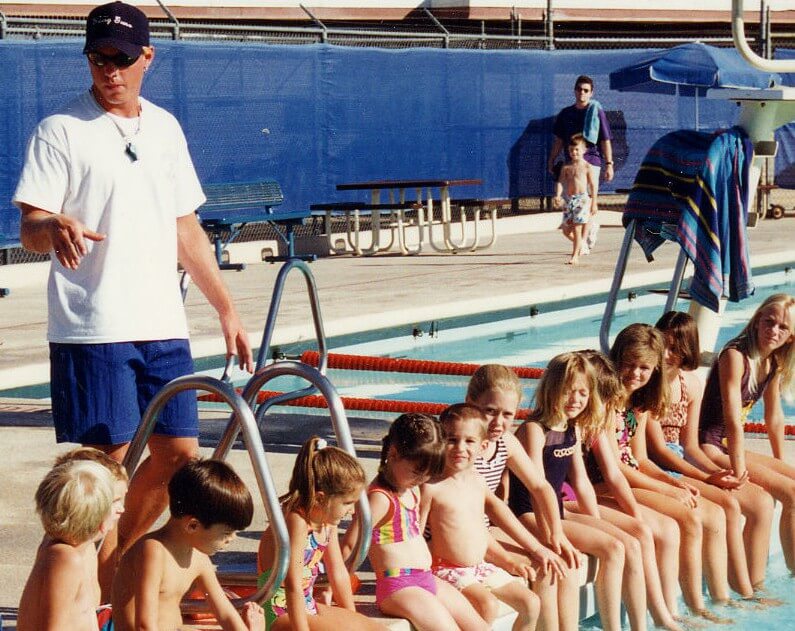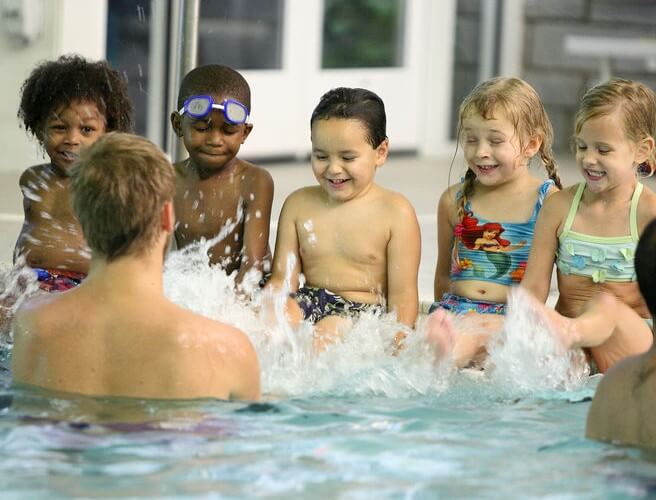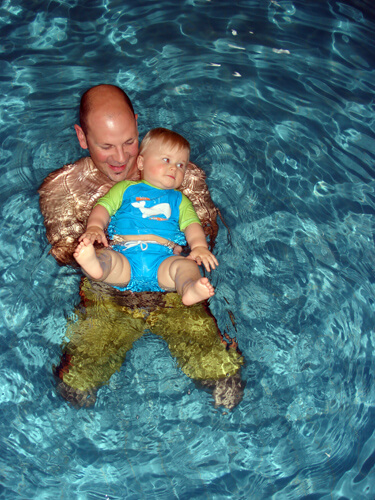6 Things To Remember When Teaching Swim Lessons

By Connor Bailey, Swimming World College Intern
Teachers. If you’re reading this, you probably know a few of them —- be they swimming inclined, or otherwise. And, depending on who you are, you either love to love them, or love to hate them. A few years ago, I became one.
After about a decade of swimming, I decided I knew enough to start teaching others the skills that I had spent so many hours honing. But, I soon learned that just because you can perform a skill yourself, doesn’t mean you can teach it to another. Early on, I made a lot of mistakes. I’m not perfect now, and I still make mistakes, but I used those initial blunders to make my own rules that have (largely) kept me out of trouble.
If you’re already teaching and looking for ways to improve, or, if you’re considering starting, here are 6 things to remember when teaching swimming lessons…
1. Have a Plan
Or, at least an idea of a plan. Planning every minute will only lead to failure, but you need to have a sense of what you want to accomplish. If you don’t plan you’re essentially teaching blind. Ask yourself: What do you want to make sure to begin the next lesson? Or, is there something new you want to try?
At the end of the day, after all your classes, take some time (5-15 minutes) and write down a few quick notes someplace permanent, (phone, paper, etc.). Then, before your classes the next day, take a quick look at what you wrote. That quick little reminder is usually all you need to remember what happened last time, what problems you had, and what you need to do today.
This is very easy. But, ironically, because it’s so easy to do, it’s also easy to dismiss. After you finish your day, the last thing you want to do is think back to your lessons. And, if you’re like a lot of swimmers, you’ve probably over-scheduled yourself.
Who has time to relax and write? You may think that you can just “wing it.” After all if you’re teaching swimming, you know what you’re doing. Right? Trust me though; you’ll thank yourself afterwards.
When I made this change, every lesson passed more smoothly and I was able to do more for each student. Plus, when the end of the day arrived I realized it had been significantly less stressful. Instead of constantly stumbling through the lessons, making a new plan every two minutes, all I had to do was take a quick glance at my paper and I was all set. It’s a very small investment in time and effort and it more than pays for itself later on.
2. Curse of Knowledge
The curse of knowledge can be explained like this: it is very hard for someone who fully understands something to communicate that “thing” to someone who does not understand it. An uninformed person knows what they don’t understand and knows what part needs more explanation. But, an informed person doesn’t instinctually know where to start. In the expert mind everything “just makes sense.”
I like to compare it to age. You may remember conversations you had, or presents you received, from someone older where it was very apparent they did not understand where you were in your life. These older people should understand what it’s like to be your age, because at one point they too had been like you. But, as soon as they are outside that age bracket, it becomes much harder to understand those who were once like them.
A big struggle of a teacher is putting yourself into the place of your student. Someone who is able to do this successfully will know exactly what instructions to give, and when.
To try and do this better, I began to teach myself. I would do a kind of one-man-show where I would take the part of both student and teacher. Then, I’d run myself through a scenario like—“You just learned arm movements, now you need to learn breathing.” This play-acting helped me to work out specific things, but also made it easier for me to think like a student during my lessons for the things I couldn’t anticipate.
One needn’t subject themselves to my particular approach, but to be successful you’re going to need to understand teaching from a student perspective, and you will need to find your own way to get into that headspace.
3. Teaching is Not a Science
If “science” means that doing X will always result in Y. Then, as with anything that involves people, teaching is not a science. You can make your own general rules, but you cannot make absolute ones. People are different and any good teacher must adjust accordingly.
I once had a student who had problems with his cross-body motor skills, telling him to concentrate on doing X did not necessarily mean that Y would happen. Even if Y almost always follows, it will not do so always and forever. But, it’s not usual physical ability; more often variations in personality and individual temperament create difference. You’ll come to appreciate this variety. It’s what keeps teaching interesting.
There are two reasons why swim teachers needn’t be afraid that their job will be replaced by a robot.
Water and robotics don’t mix well.
Robots treat everyone the same.
But, people are not the same. Every student will have different problems and different strengths. No one is perfect. Because there is no perfect student, there can be no perfect lesson plan. Every student will react a bit differently and a teacher needs to learn how to work with those differences. Trying to be a robot will get you nowhere.
4. Confidence
A student needs to trust that an instructor knows what they are doing. If a student doesn’t think you are very knowledgeable about swimming, or that you are an incompetent teacher, they may begin to: question your instruction, stop trying, or (if they’re young) try to manipulate you into doing what they want to do.
To stop your students from losing faith in your instruction, having a plan (#1) and demonstrating your knowledge through good explanation (#2) will help. But sometimes it just boils down to one thing….confidence.
You’re going to need to project confidence so that you won’t lose the trust of your students. Whether that confidence is completely scripted, or completely real, it needs to be visible. If you don’t seem confident in yourself, your students are not going to be confident in you either.
As phony as it may feel, maintaining your confidence is a prerequisite to teaching well. Without it, students will become infinitely less pliable; your knowledge and skills won’t do you any good, no matter how good they are.
5. Tension
If an unskilled student does not trust they are safe, they will be very tense. This tension will manifest itself in such things as reluctance to attempting new things, poor body position, and reduced range of motion. This kind of fear and tension wanes with increased skill, but not increased age. Two beginner swimmers, at age six and 36 respectively will have remarkably similar problems related to “staying loose.”
If you’re teaching an experienced swimmer like someone from your club-team, you should not need to worry about making them feel safe. But, because so much of swimming is about steady, smooth rhythm and correct body position, a little stress can cause a lot of disruption.
More experienced swimmers can still have problems with being tense, but in their case it’s not about fear, but frustration or anger. Keeping stress and tension down, making students feel relaxed and fostering a relatively low-stress atmosphere will help them focus on sound technique.
6. Keep Learning
Since you’ve read this far, you’re doing something right. Other instructors have their own way of doing things; they will have found their own short-cuts and rules to make their lives easier. These may be as straightforward as drills they think are effective or as subtle as the way they speak with their students.
Ask them for help. I can’t guarantee that asking another instructor what they think will always be helpful, or that they will even want to talk to you, but asking for their thoughts will never leave you less knowledgeable. Current and former coaches will also have some insights into teaching swimming technique and managing people in a pool. They can be an invaluable resource.
Sometimes it can be enough to asking one of your swimmer friends, “Have you ever done a drill that helps with this?” or even just use them as a sounding board for some of your ideas. But, the most important thing to remember: you always need to think about the advice you hear, and decide its validity yourself.
Exhibit A: if you have your reasons for thinking that my advice isn’t any good, you should feel free to disregard it—as long as you read it, thought about it, and made your decision, no one can fault you for that.
So what did you think?
Did I leave out anything you think is important?
Did I say anything you completely disagree with?
Leave a comment below and tell me your own thoughts.






Nick Gaffey
Lauren Amrein
Eleanor Wilding
Kyle Christensen
Sepideh Rajaeirad
Sepideh Rajaeirad
I keep seeing these weird comments that just give a name. What do they have to do with any of the articles?
If you are one of the people posting like this, explain yourself or leave us alone.
They are just “tagging” friends who they think would be interested in the content in this article.
This was very enlightening I hope that you would keep sharing
Emory Allen. Brooke Allen
Emma Souza
Jeanette Gant
Beau Simon
Carlos L Ch Sibaja hahahahaha
Kujtim Kito
Getting your WSI was not worth the expense and time if there are no jobs, hiring for instructors, and no client toddlers, kids, and adults to teach, coach, or involve in Metro Phoenix, Arizona in 2008-2010.
Be flexible, there are many different ways to teach a skill. Teach for success (use progressions starting with easier skills and build to more difficult). You are the best teacher but you will have good days and not so good days, Satara Post
No wonder you’re a phenomenal teacher Soozee Edminster!
Good to learn yr articles explains the importance Skill solutions and will always appreciate this..see ya